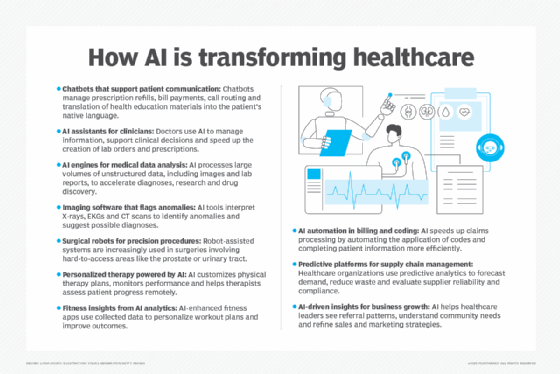
DrAfter123/DigitalVision Vectors
10 AI healthcare trends to watch in 2025 and beyond
AI is redefining the healthcare sector, with hospitals, health systems and large medical practices incorporating AI technologies into clinical and administrative workflows.
If it seems like artificial intelligence dominates healthcare headlines, it's with good reason. AI in healthcare is on track for rapid growth; research firm MarketsandMarkets, for example, has predicted an extraordinary compound annual growth rate of more than 49% for the rest of the decade, driven by investments in deep learning, remote monitoring and chronic care management. Meanwhile, McKinsey & Company has pointed to additional AI trends in healthcare, from the rapid rise of generative AI to back-office use cases, such as claims processing and insurance verification.
For executives such as Jordan Archer, chief operating officer of Charlotte, N.C.-area multispecialty group Tryon Medical Partners, AI systems are valuable because they facilitate the work that well-trained staff do every day. "They can handle processes in a more efficient manner and deliver more for patients. As an organization, we can perform better in value-based care contracts," he said.
10 ways AI is redefining healthcare
Hospitals, health systems and large medical practices are exploring many ways to incorporate AI into both clinical and administrative workflows. Some initiatives are small in scale, using AI tools in their pilot phase or focusing on individual service lines or patient populations. Others span the enterprise, especially if AI functionality has been embedded in practice management or electronic health record (EHR) systems already in place.
Here's a look at some of the AI trends expected to reshape healthcare in the years ahead.
1. Chatbots connecting with patients
As with many other industries, healthcare has embraced AI-powered chatbots to complement customer service. Based on how a patient answers a chatbot's intake questions, the chatbot can determine whether an automated system can handle an inquiry -- such as scheduling an appointment, refilling a prescription or paying a bill -- or whether a patient needs to speak to a person based on their medical symptoms or the complexity of their needs. In addition, chatbots can augment patient engagement efforts by providing evidence-based recommendations or translating educational resources to a patient's native language.
2. Boosting clinician productivity
Across the industry, survey data from Rock Health showed more than 30% of primary care physicians use AI for clerical support, such as documenting patient visits and drafting post-visit notes to patients. Close to 25% said they use AI for information management and clinical decision support. Critically, less than 10% of primary care physicians said they don't want to use AI at work. The Cleveland Clinic is one health system that has deployed AI in the exam room, with chatbots embedded in the EHR system to help retrieve information and ambient listening technology capturing notes and creating instructions for prescriptions or lab orders.
3. Sorting through data
Roughly 80% of healthcare data is unstructured, meaning it doesn't easily fit into database rows and columns. AI systems can parse unstructured data sources, such as medical images and lab reports, far more quickly than traditional analytics tools. Depending on the algorithm being used, models can provide insight into a potential diagnosis, identify high-risk patients or offer treatment recommendations. AI-powered data analysis can also help hospitals prevent adverse events, such as harmful drug interactions or sepsis infections.
4. Detecting anomalies in imaging
Imaging studies drive diagnostic and treatment decisions. However, analysis with the naked eye can be time-consuming and prone to error -- and backlogs are all too common. Image recognition tools can interpret studies such as X-rays, electrocardiograms and CAT scans to identify irregularities and suggest a potential diagnosis. AI systems can also clear studies with normal results so radiologists and other members of the care team can focus on studies that need careful review.
5. Robots assisting with surgery
Robot-assisted surgery debuted in the 1980s and, after initial trepidation among surgeons, the technology began to take off in the 2000s. The American College of Surgeons (ACS) has noted increased interest in robot-assisted surgery for procedures involving tight, cramped and sometimes inaccessible areas, particularly the prostate and urinary tract. The main benefit is a minimally invasive approach that contributes to shorter hospital stays and faster recovery times. Advances in automation should soon let robotic systems execute minor tasks such as sutures, ACS indicated.

6. Augmenting physical therapy
Practice guidelines in physical therapy tend to be based on small studies, as it can be difficult to enroll patients at a single site with the same diagnosis and treatment plan. AI can analyze real-world data from PT patients in many settings; the output of this analysis can provide personalized recommendations for individual patients and inform guidelines for specific populations in need of PT services. Meanwhile, incorporating virtual reality into PT treatment can provide immediate feedback to patients about whether a movement is being done properly and to clinicians about how a patient is responding.
7. Supplementing exercise plans
Whether created from queries to generative AI models or fitness apps gathering data from wearables, personalized exercise programs are poised to help address patients' specific wellness needs and fitness goals. A recent literature review noted individuals participating in various strength, stretching and resistance training programs showed measurable improvement compared to the control group. As with many AI use cases, though, the expert recommendation is to use AI as a supplemental tool for exercise programs but "not as a substitute for personalized, progressive, and health condition-specific prescriptions provided by healthcare and fitness professionals."
8. Streamlining the revenue cycle
Automating various stages of claims processing -- for instance, applying the right medical codes to a patient visit or filling in demographic information -- means "claims can go out the door with no human touch on the back end," Archer said. For example, Tryon Medical Partners now files about 90% of prior authorization requests automatically, and denial rates are below 2%. Before automation, the process was highly manual, leading to long wait times on the phone -- not to mention mounting frustration from patients. "This allows us to manage our labor in a more effective way," he said.
9. Strengthening the supply chain
Managing the inventory of vaccines, medications and other supplies with cold storage requirements or expiration dates can be a delicate balancing act. Keep too many items in stock and some can go bad, costing the facility money; keep too few and supplies will run out, negatively impacting patient outcomes. Predictive analytics supplements inventory management by tracking historical data and considering external factors to help anticipate demand and avoid waste. Leaders can also see which suppliers have been most reliable in meeting shipping deadlines as well as product safety requirements.
10. Optimizing business strategy
In competitive markets, hospitals and health systems need all the help they can get to reach more patients in their catchment area or identify service lines ripe for expansion. Bringing AI into sales and marketing helps organizations better understand market dynamics, such as referral patterns and specific medical needs within the population. This information can help influence business decisions that drive revenue growth.
Ensuring everyone can benefit from AI
As the industry looks to reap the benefits of these AI trends in healthcare, stakeholders have shared concerns that large hospitals and health systems are better poised than smaller practices to make the most meaningful strides. "We know that we need to support both large institutions and smaller practices, making sure that there is equitable access to these tools," Dr. Margaret Lozovatsky, vice president of Digital Health Innovations at the AMA, said late last year in an interview with the association's chief experience officer, Todd Unger.
The need for support is especially acute when it comes to using AI tools effectively, according to Dr. Brian Anderson, CEO at the Coalition for Health AI. Community-based, rural or federally qualified health centers often lack strong AI governance or the expertise to monitor how AI systems perform.
"How do they make an informed decision to buy models that perform well? How will they manage and monitor models? Can they tune models locally based on their community data?" he questioned. "Those are really important things that we will have to tackle collectively."
Brian Eastwood is a Boston-area freelance writer who has been covering healthcare IT for more than 15 years. He also has experience as a research analyst and content strategist.





